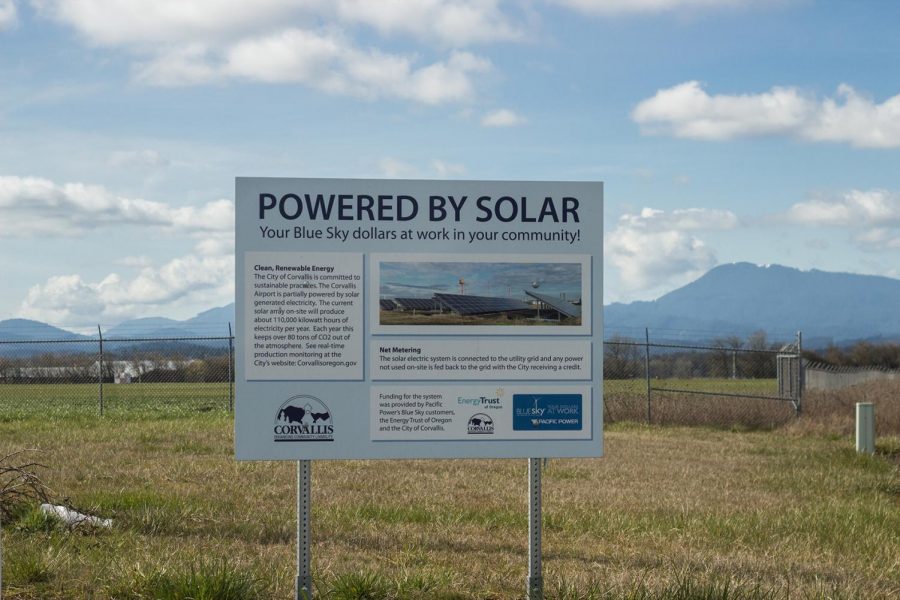Corvallis, local utilities work to implement renewable energy programs
March 2, 2020
The City of Corvallis and local power companies such as Pacific Power and Consumers Power Inc. have implemented renewable energy programs in order to reduce the area’s contribution to climate change.
Pacific Power, the main provider of electricity in the City of Corvallis, has a voluntary initiative known as Blue Sky, in which customers opt in to the program and pay an additional cost on their monthly power bill to support renewable energy efforts.
According to the Pacific Power website, customers can opt in to three options, including “Blue Sky Block,” “Blue Sky Usage” or “Blue Sky Habitat.”
“Blue Sky Block” costs $1.95 per 200 kWh block per month and supports renewable energy at a fixed price. “Blue Sky Usage” costs approximately $8 more per month and supports 100% renewable resources from Oregon, Washington and Idaho. “Blue Sky Habitat” costs about $10.50 more per month and helps restore and preserve native fish habitats in Oregon.
According to the Pacific Power website, there were over 125,000 participants in Blue Sky in 2018, collectively supporting 790,051,058 kilowatt-hours of renewable energy and reducing their combined carbon footprints by 323,931 tons of carbon dioxide.
Tom Gauntt, spokesman for Pacific Power, said the community participation rate for Blue Sky in Corvallis is 23%, meaning nearly a quarter of Corvallis Pacific Power customers choose Blue Sky.
“Corvallis has long been a leader in renewable energy, especially with using our Blue Sky program to further its own goals,” Gauntt said via email. “The City of Corvallis received the Blue Sky Legacy Award recognizing more than a decade of participation in the program.”
According to Gauntt, there are a number of other Blue Sky participants in Corvallis, including the Beit Am Jewish Community Center, Corvallis Municipal Airport, City of Corvallis Waste Water, Coho Housing Condominium Association, City of Corvallis Fire Station #1 and #4, OSU Optical Motion Tracking System, OSU WERF Wind Research and the OSU Wave Energy Linear Test Bed.
Pacific Power’s current energy resources consist of thermal energy, hydropower, wind and solar. According to Gauntt, 70% of Pacific Power’s resources come from coal and natural gas, with plants located in Utah and Wyoming. 10% comes from hydropower, with projects on the Lewis River in Washington, North Umpqua River in Oregon and Klamath River in California. 10% comes from wind and solar, with wind assets in the Columbia River Gorge, Utah and Wyoming. 10% of power is purchased off the market, meaning its source depends on what is at sale at the time.
“Pacific Power is transitioning away from coal-fired energy. By 2038 we are retiring 20 of the 24 units currently operating. At the same time, we are accelerating creation of new wind, solar and storage. During that same 18 years of expanding renewable capacity, including storage, we plan to bring on more than twice the capacity than the coal units being retired, ensuring reliable and renewable power for generations to come,” Gauntt said via email.
While Pacific Power is the primary electricity provider in the area, Consumers Power Inc. also serves 23,000 members in Benton, Lane, Lincoln, Linn, Marion and Polk counties. Consumers Powers Inc. is a non-profit, cost-based cooperative utility owned by its customers, in comparison to Pacific Power, an investor-owned utility.
Consumers Power Inc.’s mission is to provide safe, reliable and affordable power to its members, according to James Ramseyer, the director of member services at the co-op.
“Our resource mix is currently 97% emission free,” Ramseyer said via email. “Most of that, over 80%, is hydropower.”
The City of Corvallis works in conjunction with local power companies, including Pacific Power, to implement energy initiatives, according to Corvallis Public Works Director Mary Steckel.
Steckel said the city has taken a number of steps to increase its use of clean and renewable energy, including switching to LED street and traffic lights and placing thermal solar panels on several city buildings. Additionally, there are photovoltaic solar arrays at the Corvallis Public Works complex, municipal airport and two Corvallis fire stations.
“The electricity produced at our four on-site solar arrays plus Blue Sky purchases equaled 25% of our total electricity usage in 2019, up from 8% in 2013,” Steckel said via email.
Steckel said the city also plans to purchase at least 50% renewable diesel fuel this year, since it emits less carbon and particulate matter—hazardous particles that are suspended in air—than regular or biodiesel blends. Additionally, Steckel said the city has an action plan item in its Strategic Operations Plan to get to 100% renewable electrical energy by 2030.
Steckel said the City of Corvallis has specifically worked to improve efficiency at two of the city’s largest energy consumers: the wastewater treatment plant and the water treatment plant. Steckel said their efforts were focused on two areas, reducing the amount of water that’s treated through conservation outreach in the community and identifying efficiencies in how water is processed in both plants.
The latter effort is done through the Department of Energy’s program, which includes a team that consists of members from Pacific Power, Oregon Department of Environmental Quality, Energy Trust of Oregon and other communities. This team, according to Steckel, seeks the best practices and consultant advice on potential areas of improvement.
“The City of Corvallis currently derives 12.7% of overall electricity from renewable resources,” Gauntt said via email. “We continually work with the city to help strategize ways to meet their renewable energy goals, often working on strategies to energize fleets. 22% of municipal load is through Blue Sky.”
Pacific Power customers interested in how to participate can find more information on the Blue Sky Initiative webpage.










































































































